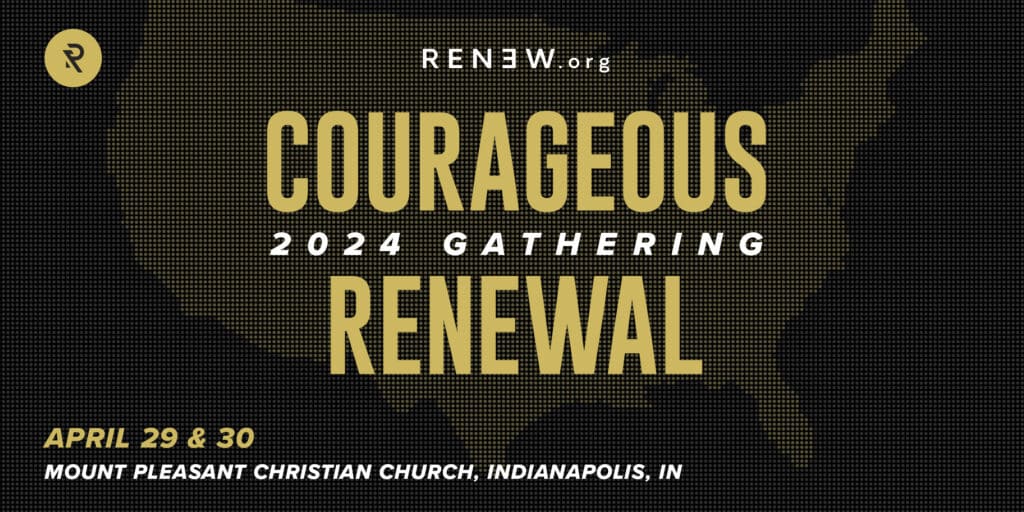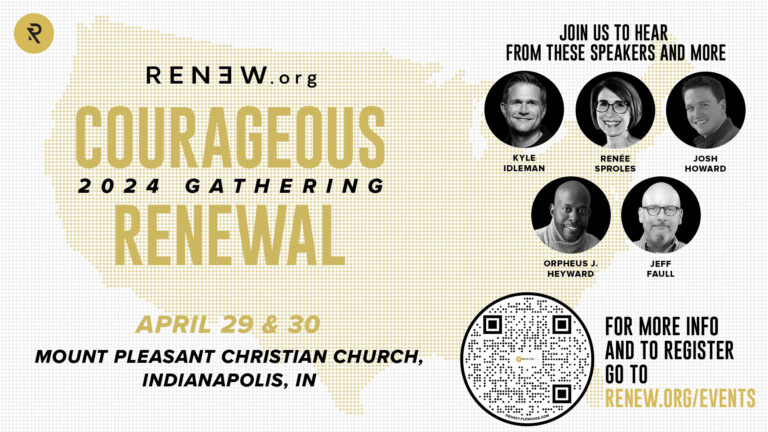We at RENEW.org believe that Jesus is coming back to earth in order to bring this age to an end. Jesus will reward the saved and punish the wicked, and finally destroy God’s last enemy, death (1 Cor. 15:26). He will put all things under the Father, so that God may be all in all forever.
The second coming of King Jesus is described in the Word of God as our blessed hope (Titus 2:13).
The second coming gives us urgency for the Great Commission—to make disciples of all nations. We like to think about and talk about the Great Commission as an inherent part of God’s original command to “be fruitful and multiply.”
God is looking for those who bear his image and who respond with faith in King Jesus and thereby have an eternal relationship with him.
We want to be disciples of Jesus who love people and help them to be disciples of Jesus. RENEW.org is a movement of disciples who make disciples who help renew existing churches and who start new churches that make more disciples.
We want to reach as many as possible, until Jesus returns and God restores all creation to himself in the new heaven and new earth.
Here are the five core, orthodox elements of what the Bible teaches about the end[1]:
- The second coming
- The resurrection of the dead
- The final judgment
- Eternal punishment
- The new heaven and new earth
These elements are foundational to an understanding of the basics. They are the focus of what Scripture teaches about end things and should be foundational to our beliefs. These are also the beliefs about the end that found themselves in the earliest faith statements of the historic church: the Apostles creed and the Nicene creed.[1]
“We want to reach as many as possible, until Jesus returns and God restores all creation to himself in the new heaven and new earth.”
When it comes to end times, however, there are multiple issues that can come up which are not essential to the faith. Faithful, thoughtful Christians can respectfully disagree on these secondary and third-level issues without it affecting the integrity of their Christian faith.
We use the following diagram at RENEW.org Network to help delineate between the essential elements of the faith and other elements that might be important (second bucket) or personal (third bucket). Our free ebook Conviction and Civility maps out how we understand these items. Some describe the different levels of belief using the metaphor of how things are written—in blood, ink, and pencil.

We believe the following end-time items are important and personal. They are not essential for salvation.
- The 1,000-year reign
- Cosmic disruptions and tribulation on earth at the end
- Increase in false prophets and wickedness
- The anti-Christ
- The conversion of Israel
“When it comes to end times, however, there are multiple issues that can come up which are not essential to the faith.”
As a case in point, one of the most prominent nonessential issues which should interest students of the Bible is what to do with the “1,000 years” of Revelation 20. Here is how the apostle John describes it:
And I saw an angel coming down out of heaven, having the key to the Abyss and holding in his hand a great chain. He seized the dragon, that ancient serpent, who is the devil, or Satan, and bound him for a thousand years. He threw him into the Abyss, and locked and sealed it over him, to keep him from deceiving the nations anymore until the thousand years were ended. After that, he must be set free for a short time (Rev. 20:1-3).
Is this millennium meant to describe a time period of 1,000 365-day years? Or is it meant to be symbolic for something else? And when will this millennium occur? Or has it occurred already? There are faithful, intelligent Christians who hold varying views on the millennium.
Here is the truth: there are five major models or paradigms of end-time teachings to which true disciples of Jesus hold. As long as we agree on the five end-time essentials, we want to be careful to work with and not divide from those who hold each of these five views.
Note the summaries and how each one incorporates the five essential beliefs described above.
Historic Amillennialism – (pronounced ah-millennialism)
These Christians believe that Jesus is currently reigning in heaven and on earth, through the church. The 1000 years are symbolic of a long, undefined time which began when Jesus rose from the dead, bound Satan, and the church was unleashed. Because he is bound and demonic attacks can be thwarted, Satan cannot stop the church from expanding into the whole world. This reign will last until just before the end, when Satan is unleashed. Augustine, the famous Christian writer in the 400s championed this view—and it was adopted by Roman Catholics and initially by most Protestants. Christ is ruling in heaven—with the dead—and through the church. Because the world itself is full of turmoil and evil, there will be growing wickedness and tribulation in the world. Jesus’ return will save his followers from annihilation at the hands of evil forces. His second coming will usher in the final judgment and then the full consummation of his kingdom.
Historic Premillennialism – (pronounced pre-millennialism)
These Christians believe that when Jesus returns to the earth, he will personally usher in a literal 1000-year period of peace and prosperity on earth. At the end of the 1000-year reign, there will be a final judgment of all people who have ever lived. Before the return of Jesus and his 1000-year reign, there will be growing wickedness and tribulation in the world. Jesus’ return will save his followers from annihilation at the hands of evil forces. Then, again, after the 1000-year reign, there will be growing wickedness, as Satan is once more allowed to deceive the nations. But then God will institute the final judgment and Satan will be finally defeated. This view was popular in the early church and is a widely held view by many Evangelical scholars today.
Postmillennialism
These Christians believe we will experience a golden age of earthly peace in the future, before Jesus returns. It may be 1000 years, but that number most likely is symbolic and signifies a long period of “good times on earth.” Despite setbacks along the way, the Church will gradually convert the world through the preaching of the gospel, most people in the world will become Christians, there will be peace on earth, and life will get better and better. At the end of this “golden age,” Christ will return, the dead will be raised, the final judgment will be pronounced, and the new heavens and the new earth will be revealed. This is the favorite view of liberal Protestants, but it was also the view of early Puritans like Jonathan Edwards.
Dispensational Premillennialism
Starting around 1840, there was a group of Christians who heavily stressed a distinction between God’s dealings with Israel and the Church. They advocated that history should be divided up into different periods called “dispensations.” In each of these dispensations, God deals differently with people. So, many Old Testament promises were never meant to apply to the church (as the other perspectives typically believe), but they will apply to Israel at the end of time, when God focuses back on that dispensation. Based upon a unique and recent understanding of Daniel 9, they came to believe that, seven years before the full second coming of Jesus (they believe the second coming will be in two parts), there will be a partial coming where Jesus secretly removes (raptures) Christians before the tribulation that will come. At this point, God’s attention will be focused on Israel. This became a popular view among fundamentalists, Pentecostals/Charismatics, many popular writers in the USA, such as Hal Lindsey’s Late Great Planet Earth, The Left Behind Series, etc., and is strongly promoted at Dallas Theological Seminary.
Preterist Amillennialism
The big idea here is that the vast majority of prophecy is complete. The events in Revelation are by and large symbolic imagery about events in the past. The book of Revelation is written using ancient symbols and imagery of things that were fulfilled in the first century or two. Preteristic amillennialists (like historic amillennialists) believe that Jesus is currently reigning in heaven and on earth, through the church. The 1000 years are symbolic of a long, undefined time which began when Jesus rose from the dead, bound Satan, and the church was unleashed. The only outstanding expectation is the second coming of Jesus, the resurrection of the dead, the final judgment, and heaven and hell. Old Testament prophecy was fulfilled in the past in ancient Israel or in the church. The book of Revelation was written to describe events in the first century and all references to the tribulations, the anti-Christ, and Israel were symbolic or metaphorical images to things already fulfilled in the past.
Did you read anything in the five description which you did not agree with? Likely you did. Yet did you read anything which disagrees with the essential beliefs of Christianity? No, everything you read is in line with our faith’s essentials, even though there are significant differences between the millennial views.
Contrast the essential agreement shared by the five views above with a radical version of the fifth view (Preterist Amillennialism) called Extreme Preterism:
Extreme Preterism
A small number of amillennialists are hyper-preterists. They take the view that the second coming and the resurrection of the dead have already occurred. The second coming and final resurrection were actually spiritual events tied to the destruction of the Temple in Jerusalem in A.D. 70. Extreme preterism is heretical because it denies a historic understanding of three key essentials: a future second coming, a future resurrection of the dead, and a future final judgement. Again, these three doctrines are embedded in the essentials of New Testament teaching and they are imbedded in the earliest Christian faith statements: 1) the apostles’ creed and 2) the Nicene creed.
As we saw from the first five positions, discussing end times is often a matter of agreeing on the essentials but disagreeing on the nonessentials.
Such disagreements are meant to be mutually sharpening and to encourage us to study the text more carefully, even as we reaffirm our fellowship with each other.
Yet, as we see from the Extreme Preterist position, end-times views can drift far enough away from the essentials of the Bible that they become dangerous to the person who holds them.
“Discussing end times is often a matter of agreeing on the essentials but disagreeing on the nonessentials.”
It takes discernment to know the difference, and in order to develop this discernment, we need to be humble and serious students of the Bible.
[1] Dayton Hartman does a good job in showing how these five elements are key. He demonstrates their connection to the early creeds as a key benchmark. See Jesus Wins: The Good News of the End Times (Bellingham, WA: Lexham Press, 2019)
If you are interested in checking out a class on end times theology led by Bobby Harrington, the classes are available for viewing in our digital locker, which you can access by setting up a recurring donation here.











